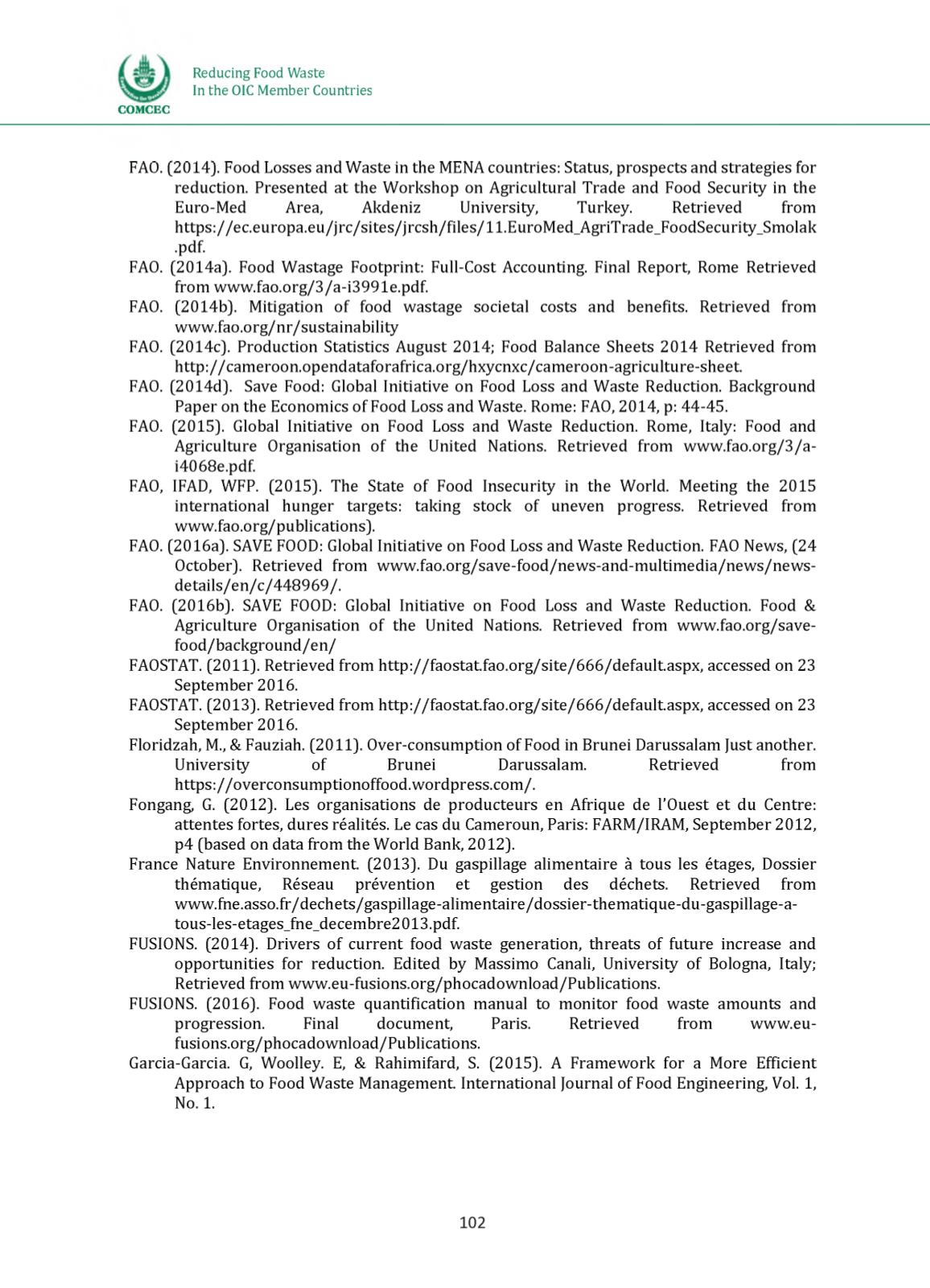

Reducing Food Waste
In the OIC Member Countries
COMCEC
FAO. (2014], Food Losses and Waste in the MENA countries: Status, prospects and strategies for
reduction. Presented at the Workshop on Agricultural Trade and Food Security in the
Euro-Med
Area,
Akdeniz
University,
Turkey.
Retrieved
from
https://ec.europa.eu/jrc/sites/jrcsh/files/11.EuroMed_AgriTrade_FoodSecurity_Smolak.pdf.
FAO. (2014a). Food Wastage Footprint: Full-Cost Accounting. Final Report, Rome Retrieved
from
www.fao.org/3/a-i3991e.pdf.FAO. (2014b). Mitigation of food wastage societal costs and benefits. Retrieved from
www.fao.org/nr/sustainabilityFAO. (2014c). Production Statistics August 2014; Food Balance Sheets 2014 Retrieved from
http://cameroon.opendataforafrica.org/hxycnxc/cameroon-agriculture-sheet.FAO. (2014d). Save Food: Global Initiative on Food Loss and Waste Reduction. Background
Paper on the Economics of Food Loss and Waste. Rome: FAO, 2014, p: 44-45.
FAO. (2015). Global Initiative on Food Loss and Waste Reduction. Rome, Italy: Food and
Agriculture Organisation of the United Nations. Retrieved from
www.fao.org/3/a-i4068e.pdf.
FAO, IFAD, WFP. (2015). The State of Food Insecurity in the World. Meeting the 2015
international hunger targets: taking stock of uneven progress. Retrieved from
www.fao.org/publications).
FAO. (2016a). SAVE FOOD: Global Initiative on Food Loss and Waste Reduction. FAO News, (24
October). Retrieved from
www.fao.org/save-food/news-and-multimedia/news/news-details/en/c/448969/.
FAO. (2016b). SAVE FOOD: Global Initiative on Food Loss and Waste Reduction. Food &
Agriculture Organisation of the United Nations. Retrieved from
www.fao.org/save-food/background/en/
FAOSTAT. (2011). Retrieved from
http://faostat.fao.org/site/666/default.aspx,accessed on 23
September 2016.
FAOSTAT. (2013). Retrieved from
http://faostat.fao.org/site/666/default.aspx,accessed on 23
September 2016.
Floridzah, M., & Fauziah. (2011). Over-consumption of Food in Brunei Darussalam Just another.
University
of
Brunei
Darussalam.
Retrieved
from
https://overconsumptionoffood.wordpress.com/.Fongang G. (2012]. Les organisations de producteurs en Afrique de l’Ouest et du Centre:
attentes fortes, dures réalités. Le cas du Cameroun, Paris: FARM/IRAM, September 2012,
p4 (based on data from the World Bank, 2012).
France Nature Environnement. (2013). Du gaspillage alimentaire à tous les étages, Dossier
thématique, Réseau prévention et gestion des déchets. Retrieved from
www.fne.asso.fr/dechets/gaspillage-alimentaire/dossier-thematique-du-gaspillage-a-tous-les-etages_fne_decembre2013.pdf.
FUSIONS. (2014). Drivers of current food waste generation, threats of future increase and
opportunities for reduction. Edited by Massimo Canali, University of Bologna, Italy;
Retrieved from
www.eu-fusions.org/phocadownload/Publications.FUSIONS. (2016). Food waste quantification manual to monitor food waste amounts and
progression.
Final
document,
Paris.
Retrieved
from
www.eu- fusions.org/phocadownload/Publications.Garcia-Garcia. G, Woolley. E, & Rahimifard, S. (2015). A Framework for a More Efficient
Approach to Food Waste Management. International Journal of Food Engineering, Vol. 1,
No. 1.
102
















